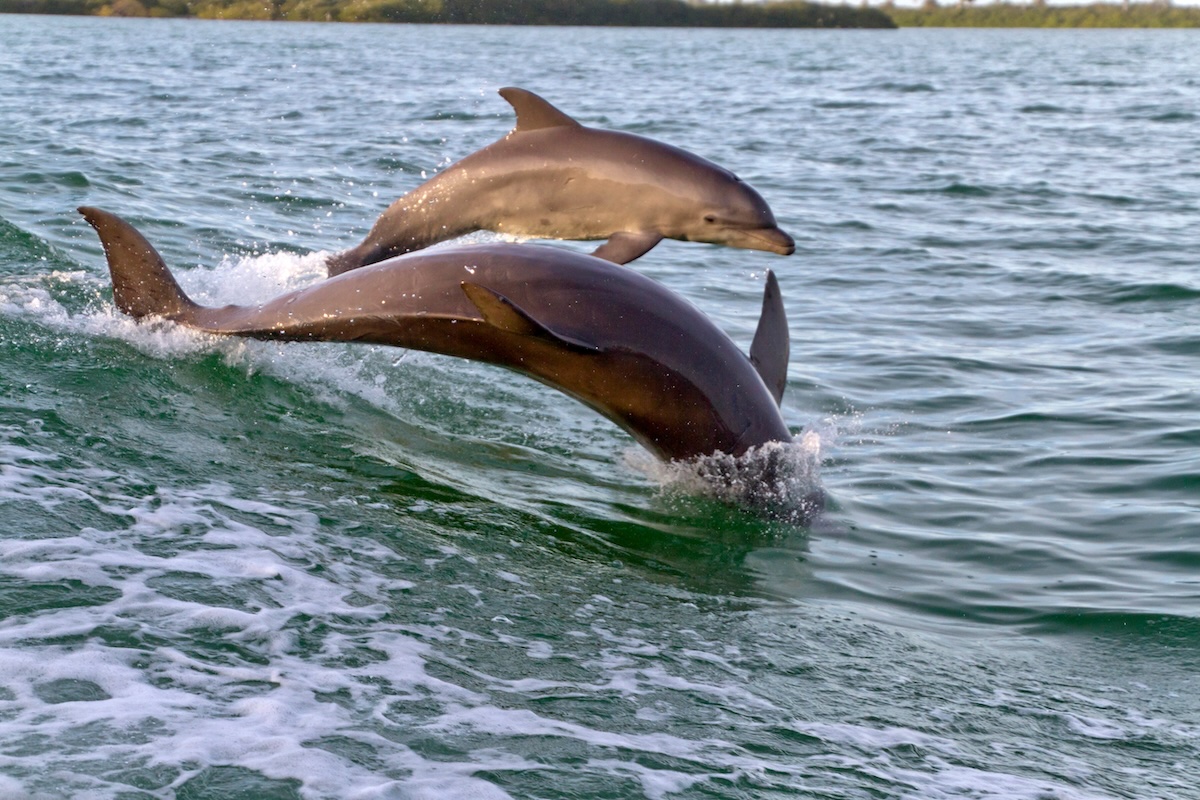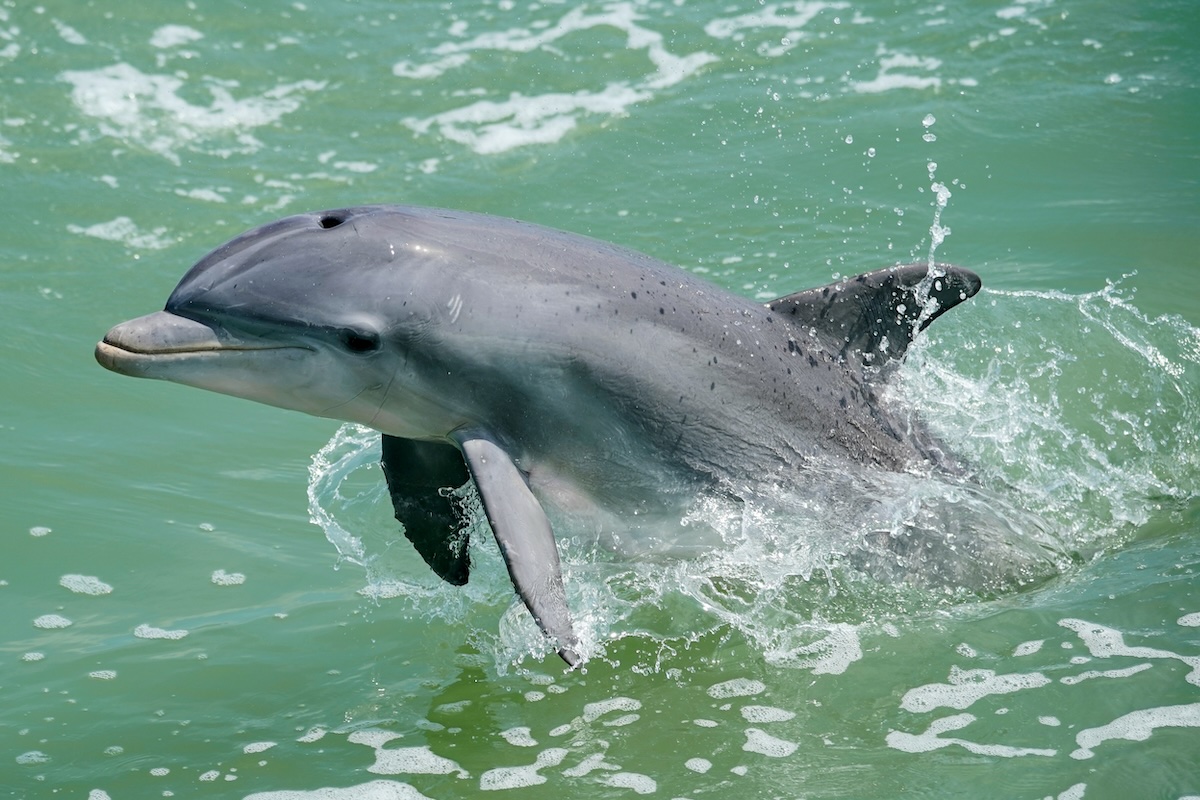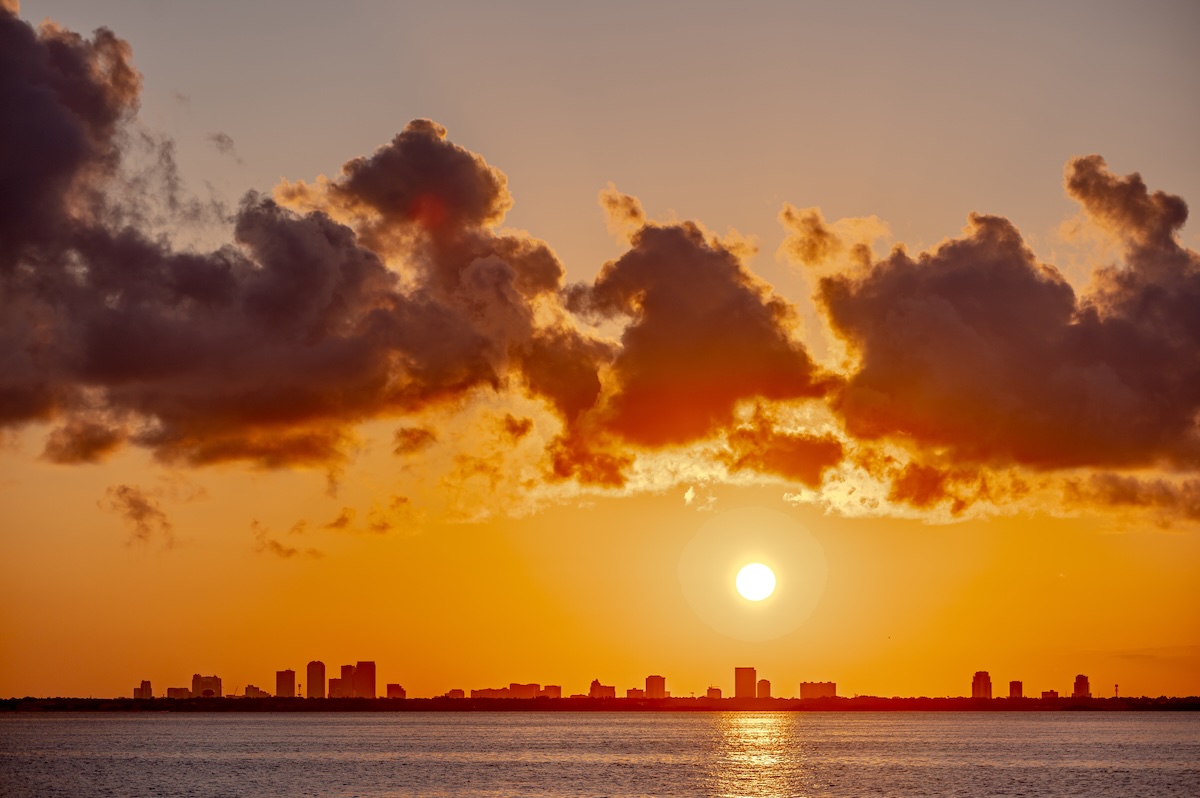Few true “Florida wildlife encounters” are as effortless as seeing dolphins from a boat on the Gulf Coast. (Well, other than dodging seagulls eyeing your lunch on the beach.) Around Tampa Bay, Sarasota, and Anna Maria Island, bottlenose dolphins are year-round residents—surfacing beside boats, weaving through inlets, or gliding past sandbars where the tide runs shallow.
That’s right: Tampa’s coastal waters are home to hundreds of resident bottlenose dolphins, so visitors can see them any time of year. What changes from season to season are the details: boat traffic, water clarity, feeding activity, and where pods tend to spend their time.
This guide focuses on when and where dolphin activity peaks through the year, plus what time of day gives you the best odds for easy sightings. So whether you’re paddling a kayak, booking dolphin boat tours in Tampa, or just standing at the edge of a pier with your morning coffee, much of the same information applies.
Table of Contents
ToggleDolphin Behavior in the Tampa Bay Area

Tampa Bay’s dolphin population is mostly locals. In other words, these aren’t migratory visitors “passing through” the area only during certain times of the year. They are resident pods that have adapted to our region’s mix of estuaries and barrier islands. Sarasota in particular has one of the longest-running dolphin research programs in the world, and researchers have observed that many individuals spend their entire lives within a specific home range centered on Sarasota Bay.
Bottlenose dolphins move through a range of habitats: the shallow grass flats off Anna Maria Island, the deeper channels around Egmont Key, and the quieter bays and rivers feeding into Tampa Bay itself. Because water temperatures rarely drop below their comfort range, they remain active all year. What varies is how visible they are—dictated by factors like seasonal water clarity, prey concentration, and human activity on the water.
The Best Seasons for Dolphin Watching
You can see dolphins on Florida’s Gulf Coast any month, but each season highlights something slightly different about their behavior or the surrounding environment. Here’s what to expect as the year progresses.
Spring (March – May)
Spring’s one of the prettiest times you’ll ever see this water. The skies stay clear, the bay lights up that bright turquoise color, and the dolphins seem to know it. Dolphins are all over the place this time of year—feeding close to the inlets, rolling through the channels, and giving everyone on the boat a good show. As winter’s cooler fronts fade, the water begins to clear and warm. Baitfish schools return to the bays, drawing dolphins closer to inlets and bridge channels where tidal flow concentrates their prey.
Morning boat tours often report the highest activity this time of year—calm seas, low glare, and dolphins feeding near the surface. The weather is warm but not oppressive, making it great for half-day eco-tours or paddleboard outings around the mangroves near Lido Key and Fort De Soto.
Because the weather is more dependable than usual this time of year, spring is when many operators begin running their full dolphin tour schedules again. The clear skies and gentle mornings create ideal viewing conditions for small-group excursions, and calmer tides make it easy to reach inshore areas where dolphins gather to feed. Booking early in spring often means lighter crowds and more personalized experiences on the water—something families and photographers especially appreciate before the busier summer season arrives.
Summer (June – August)
Summer brings calmer seas and longer days, which means plenty of dolphin activity in open water. It’s common to see pods escorting boats to Egmont Key or leaping near the wake as charter traffic heads offshore.
The Gulf can feel like bathwater by late July, so dolphins often shift to deeper, cooler channels during mid-afternoon heat. Early morning and late evening tours catch them nearshore, while mid-day sightings are more likely along deeper passes or beyond the sandbar edges around Anna Maria Island. Summer storms can briefly cloud the water, but they also cool surface temperatures—often triggering bursts of surface play afterward.
Summer is when demand for dolphin-watching tours peaks, and for good reason: the long daylight hours allow captains to offer more departure times, from sunrise to sunset cruises. Morning and evening trips tend to be the most comfortable and photogenic, with dolphins often riding boat wakes as the Gulf glows gold. It’s also prime time for combination tours—many guests pair dolphin watching with shelling or sandbar stops near Egmont Key or Passage Key, taking advantage of calm seas and consistently warm temperatures.
Fall (September – November)
Fall is one of the Gulf Coast’s underrated dolphin-watching seasons. As summer crowds fade, the bays calm down, water clarity improves again, and dolphins return to the shallows around Anna Maria Sound and Palma Sola Bay. The sea surface cools gradually, and the change draws more baitfish toward the shoreline—especially mullet schools preparing to migrate south.
During these months, dolphin pods often take advantage of the abundant prey in the inlets and around bridge pylons. Sightings are frequent near Longboat Pass and the mouth of the Manatee River, where dolphins herd fish against seawalls and chase them through tight channels. For those who prefer a slower pace, fall tours also tend to be quieter—fewer boats, softer light, and more relaxed conditions overall. The combination makes this one of the most rewarding times for photographers hoping to capture a dorsal fin breaking through mirror-flat water.
Autumn tours have a relaxed, locals-only feel. With fewer visitors on the water, guides can linger longer in the quieter coves and channels where dolphins hunt, giving you more time for observation and photography. The lighting this season—especially on late-afternoon cruises—is exceptional, and the weather is still warm enough for comfortable, open-air outings. Many repeat guests prefer booking in fall for the balance of excellent dolphin viewing, less crowds/boat traffic, and tour availability that can feel more relaxed than in the peak summer months.
Winter (December – February)
Because Tampa Bay and Sarasota Bay have such mild weather year-round (It is Florida, after all!) most dolphins stay put even when the water cools to the upper 60s. With fewer storms and less boat traffic, the water can turn strikingly clear. Especially so on still mornings after a cold front passes.
Many local guides consider winter the best time for peaceful, unhurried dolphin tours. The air is crisp, the bays are glassy, and sightings tend to happen closer to shore as dolphins hunt near tidal creeks and man-made structures where fish gather for warmth.
The quieter atmosphere also lets you hear more—the breathy exhale as a dolphin surfaces or the faint splash as one tail-slaps to corral fish. Even for longtime residents, winter mornings on calm water can still feel remarkable.
Seeing dolphins in winter can surprise guests who assume the season is slow. In reality, winter is one of the best times to see dolphins against the clearest water of the year. Cooler air and lower humidity make for comfortable mornings on the bay, and the generally calmer conditions allow tour guides to explore areas that summer crowds sometimes make less accessible. Many visitors time their trips around the holidays, finding that a winter dolphin cruise is a peaceful way to experience Florida’s coast at its most serene—quiet, glassy, and full of life just below the surface.
Best Times of Day to See Dolphins

Throughout the year, the best time to see dolphins on Florida’s Gulf Coast usually falls in the early morning or late afternoon—periods when the light is soft, the wind is calm, and surface visibility is high. Dolphins are diurnal, meaning they’re active during daylight, but they feed most aggressively when the tide is moving and boat noise is minimal.
| Morning | Right after sunrise is about as good as it gets. The bay’s calm, the water’s clear, and the baitfish are right up near the surface. That’s when dolphins are most active—you’ll see them working the sandbars and chasing fish along the markers. If you can get out on an early tour, you’ll usually catch them before the traffic starts stirring things up. It’s the best window for those natural, unhurried encounters. |
| Midday | Once the sun gets higher, the dolphins tend to take it easy. You’ll still see them, but they’ll hang a little deeper or stick to shaded spots around bridges and channels. We’ll sometimes spot them near open passes too, though the glare can make them tricky to pick out from a distance. Still, when one surfaces right beside the boat, you’ll forget all about the heat. |
| Evening | Sunset trips are a whole different mood—slow, calm, and golden. The light gets soft, the water turns glassy, and dolphins often retrace their morning routes heading back inshore. Out by Anna Maria, you might see them break the surface right in front of the setting sun. It’s one of those moments where everyone on board just goes quiet for a second. |
Tide movement also plays a role. Incoming tides carry cooler, oxygen-rich water from the Gulf, drawing baitfish into the bays—and dolphins tend to follow. Checking a tide chart before heading out can help you plan for those peak windows.
Tips for Dolphin Watching Around Tampa Bay, Sarasota, and Anna Maria Island
- Book with local operators who know the pods. Many of the dolphins here are identifiable by fin markings, and long-term guides can often tell you their histories.
- Choose calm-weather days. Wind and wave action reduce visibility. Ideal conditions are light winds under 10 mph and clear water.
- Keep a respectful distance. Federal law prohibits approaching within 50 yards of wild dolphins. If they swim toward you, maintain course and speed—let them choose the interaction.
- Use polarized sunglasses. They cut surface glare, making it easier to spot fins or the shimmer of fish schools that often precede dolphins.
- Bring binoculars for shore viewing. Piers like Rod & Reel or the Sunshine Skyway area can yield sightings from far away. However, out on the water, dolphins frequently come close enough that you won’t need binoculars at all—sometimes surfacing just feet from the hull, riding the wake, or circling playfully.
- Watch for birds. Diving pelicans or circling terns can signal bait activity—and dolphins are rarely far behind!
A Year-Round Gift of the Gulf

Every season on Florida’s Gulf Coast has its signature—spring clarity, summer energy, fall calm, winter stillness—but dolphins are the constant thread tying them together. Whether you’re setting out from a Sarasota marina, idling off Bean Point on Anna Maria, or scanning the skyline near the Skyway Bridge, when you’re in the Tampa Bay Area you’re in one of the best places to see dolphins in the United States.
If you’d rather leave the spotting to someone who knows where to look, fortunately you can find dolphin tours in Tampa Bay, Sarasota, and Anna Maria Island. Near AMI, boats weave through grass flats where dolphins hunt, then idle just long enough for everyone onboard to watch them glide by. It’s not unusual for a few curious ones to approach—rolling sideways for a look, cutting across the wake, or diving right beneath the bow. Even in busier waters toward St. Pete and downtown Tampa, local captains know the routes where dolphins follow fishing boats and tide lines, turning an everyday bay cruise into a close encounter.
For visitors, these tours make it effortless. For locals, they’re a reminder of what’s been right in front of us all along—the easy magic of a morning on the bay, a few miles of open water, and a flash of silver that never quite gets old.
See the Dolphins of Tampa Bay Up Close

If you’ve ever dreamed of watching dolphins glide through open water just a few feet from the boat, Tampa Bay is the place to make it happen. Around here, spotting them isn’t a lucky break—it’s part of the day. These are the same bottlenose dolphins that inspired Flipper: curious, quick, and endlessly social. They love to play in a boat’s wake, surfacing close enough that you can hear them exhale before they slip beneath the waves again.
It’s an experience that feels spontaneous every time, even for locals who’ve lived here for years.
Island Way Excursions provides some of the best dolphin tours in Florida’s Gulf Coast, covering the waters around Tampa Bay, Sarasota, and Anna Maria Island. Their captains know the local pods by sight, often greeting dolphins that have been cruising these bays for decades. The trips blend just the right amount of relaxation and discovery—a few hours on the water where you might see dolphins leap beside you, pelicans diving nearby, and the Gulf turning to glass as the sun starts to set.
Book your dolphin boat tour with Island Way Excursions today, and see for yourself why these waters are famous for friendly encounters and unforgettable moments with Tampa Bay’s resident dolphins!



